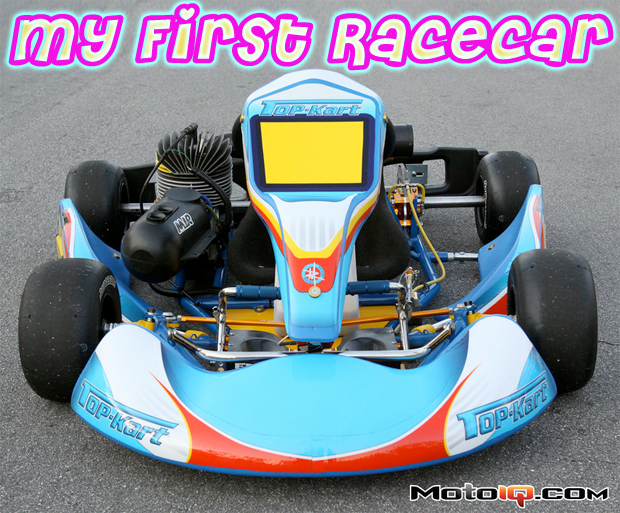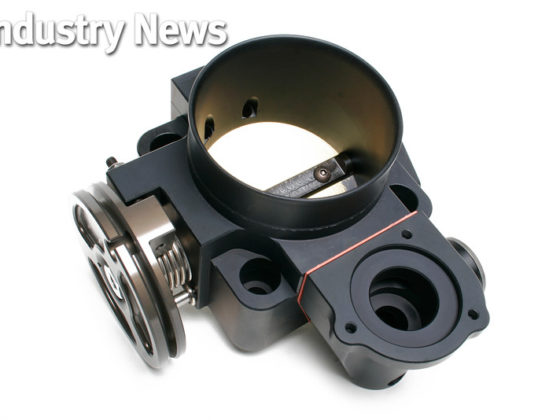
Christa's first Racer
By Mike Kojima
What does a 9 year old girl want, a pony? An all-you-can-carry gift certificate from Hello Kitty? No, apparently she likes carbon fiber. OOOH! Carbon fiber! My daughter Christa squealed when she saw the Noonan Racing foot box that I got so she could reach the pedals on her Top Kart, racing go kart.
 |
| Christa's Top Kart Chassis is a 2006 so its technology is nearly the same as the late model Top Karts. The chassis was completely redesigned and rehomologated by the FIA in 2006. Every chassis used in WKA and IKA competition must carry an FIA certification for rules compliance and safety. Most local sanctioning bodies require a current certification so be sure that what you buy used is still eligible for racing! |
 |
| A Cadet class kart is no kids toy, it is capable of pulling over 2 g's in a corner and speeds of over 60 mph. It is quite a sophisticated racing machine, that bristles with engineering alloys and billet parts. It has more in common with a formula car than a sedan. Let us take you on a tour of what makes it tick. |
 |
| The kart's backbone is a seemingly simple tube frame made of tig welded 28mm chrome moly tubing, however there is much more than meets the eye. Since the kart has a live axle with no differential, it is critical that the inside rear wheel lifts to different degrees in cornering. Too little lift and the kart understeers and the bind wastes power on corner exit. Too much lift and the kart oversteers and can't put power down out of turns. The frame must flex in a controlled way to tune the lift. Since the kart has no suspension, the chassis flex also helps the tires find traction. The tube diameter, bends , layout and wall thickness are all carefully engineered to give controlled flex. The search for optimization of the chassis is continuous and many manufactures come out with new chassis variants every year to chase the state of art. |
 |
| This ugly plastic bumper messes up the lines of the kart but it is required for racing in 2010 in some local races. It is FIA tested and certified. Its job is to prevent wheel to wheel contact which can cause flipping and to absorb impact. |
Christa had been tearing it up on track days at California Speedway in her Emmick kids Kart inherited from Ground Control's Jay Morris's kid's when they outgrew it. Christa wanted to start racing and we found that she was too old to race Kids Class and she would need a new Cadet class kart to be able to run.
 |
| The side pods and nerf bar do several things. These parts must be tested and certified by the FIA for impact absorption and to help reduce the chances of tires touching which can cause a bad accident. They also help aerodynamics and the nerf bars are part of the system to tune chassis flex. On the Top Kart Cadet chassis, they are designed to be fully floating and not affect the chassis stiffness, probably because cadet drivers are lighter and the chassis needs more flex. You can see the articulated joint to keep the bar free floating. |
 |
| The front bumper is also certified for impact absorption and anti wheel touching. It also helps aerodynamics. It's support bar is an adjustable torsion bar who's mounts are adjustable. When the bar is tight, it stiffens the front end helping traction on a slippery track. On tracks that have good grip, it can be loosened to help reduce weight transfer. The wide washers on the mounts help with tuning from full loose to full stiff by adding variable friction. |
A real racing kart is not a lawnmower engine powered kids toy but a serious and sophisticated racing machine with a lot of technology and a development history that goes way back to the late 50's when the kart was first invented. Although in most classes the engine is a spec engine with closely controlled and inspected internals, the chassis is highly adjustable and the art of kart chassis tuning very critical for being competitive.
 |
| Most of the mods we did were to fit Christa's small frame in the Cadet kart that was probably designed to fit tweens to teenagers. We changed the stock seat to this smaller Tillet seat. On a kart, the seat is actually a tunable item that is part of the chassis. This Tillet is medium stiffness and we installed it with slippery plastic washers and slightly loose bolts so it would have minimal affect on the chassis stiffness. Some people set the seat in the chassis stiffly and add extra stays to stiffen the chassis more. We opted for a padded seat to take up room in the seat and to get Christa higher in the kart so she could see. For light drivers a higher CG helps the kart find traction. Kart chassis set-up is about opposite as a cars so throw away what you know when setting up a kart. |
 |
| Carbon fiber and CNC machined billet aluminum makes a little girl raised in a racing household drool. Although a little expensive, the Noonan racing pedal box is a lifesaver when fitting a small driver in a large chassis. The pedal box is just like one found in real race cars. It gives more flexibility to place the pedals closer and gets the driver's legs above the tie rods. There is no way Christa could even come close to fitting in the kart without it. The price is still cheaper than our time if we were to fabricate something ourselves and it is so pretty. |
A bit of research led us to the Top Kart brand. Made in Italy, Top Karts seemed to be a Kart with a winning trend in Cadet class. There were also several Top Kart dealers in our area with a large inventory of parts and good service which is important for racing. A Cadet kart is a medium size kart with a track width of less than 50″ that bridges the gap between adult karts and kids karts. Chassis choice is critical in kart racing with a good fairly current chassis needed to be competitive as kart development is always progressing.
 |
| Although Christa fits in her Emmick Kids Kart perfectly, she has to move up to the much larger Cadet Class due to her age. |




